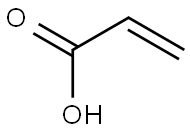Production methods of acrylic acid
Background
Acrylic acid, also known as 2-acrylic acid, vinyl formic acid, vinyl carboxylic acid, septic acid. Redtenbach J was first made in 1843. Acrylic acid is an important organic synthesis raw material and a synthetic resin monomer, and is a vinyl monomer with a very fast polymerization rate. It is the simplest unsaturated carboxylic acid, consisting of one vinyl group and one carboxyl group. Pure acrylic acid is a clear, colorless liquid with a characteristic pungent odor. It is miscible with water, alcohol, ether and chloroform and is prepared from propylene obtained from oil refineries. On October 27, 2017, the list of carcinogens published by the World Health Organization's International Agency for Research on Cancer was preliminarily sorted for reference, and acrylic acid was included in the list of 3 types of carcinogens.

Picture 1 The physical map of acrylic acid
The properties of acrylic acid
The molecular formula of acrylic acid is C3H4O2 and the molecular weight is 72.06. Acrylic acid is a colorless liquid with pungent odor, corrosiveness and strong acidity. Acrylic acid is soluble in water, ethanol and ether, and also soluble in benzene, acetone, chloroform, etc. The melting point is 13.5°C, the boiling point is 140.9°C, and the density (20/4°C) is 1.0611g/cm3.
Acrylic acid is a colorless liquid. Strong organic acid. It has a pungent sour odor and produces smoke. Below the melting point into needle-like crystals. The relative molecular mass is 72.06. Relative density 1.0511. Melting point 13.5 ℃. Boiling point 141.6°C, 122°C (53.329×103Pa), 103.3°C (26.664×103Pa), 86.1°C (13.332×103Pa), 66.2°C (5.333×103Pa), 48.5°C (2.000×103Pa), 39°C (1.333×103Pa) ), 27.3°C (0.667×103Pa). Flash point 68.3 ℃. Refractive index 1.4224. Soluble in acetone and benzene, miscible with water, ethanol and ether. It is corrosive, chemically active, unstable, and easy to polymerize when exposed to oxygen. Polymerization inhibitors such as hydroquinone or methoxyhydroquinone can be added during storage.
The chemical properties of acrylic acid are lively. Acrylic acid is easily polymerized in air, and can be reduced to propionic acid by hydrogenation. Addition of acrylic acid and hydrogen chloride generates 2-chloropropionic acid. Acrylic acid can be used in the preparation of acrylic resins and other organic synthesis. Acrylic acid can be obtained by the oxidation of acrolein or the hydrolysis of acrylonitrile, and it can also be obtained by carbon monoxide, acetylene and water under the action of nickel catalyst.
The production methods of acrylic acid
Since the industrial production of acrylic acid and ester in the 1930s, it has undergone the cyanoethanol method, the REPPE method, the ketene method, the acrylonitrile hydrolysis method and the propylene oxidation method. The first four processes have been basically eliminated due to technical and economic reasons.
The propylene oxidation method was developed in the 1960s and was initially divided into a one-step method and a two-step method. After the 1980s, the newly built and expanded acrylic acid plants adopted the two-step propylene oxidation method.
In 1995, BASF closed the last Reppe process plant in Ludwigshafen, Germany, and in 1999, Ciba Specialty Co., Ltd. closed its only acrylonitrile process plant in Bradford, England, making propylene oxidation the only way to produce acrylic acid at present.
In 2012, the global demand for crude acrylic acid (esterified acrylic acid) reached 4.2 million tons per year, and China's consumption demand was 1.354 million tons. Acrylic acid and its industrial chain system are huge, and its applications are in various fields of the national economy. There are nearly a thousand kinds of products. The largest consumption field is the acrylic acid ester industry, which accounts for 50% to 60% of the consumption of acrylic acid.
The application of acrylic acid
The largest use of acrylic acid is the production of general-purpose acrylates, including methyl acrylate, ethyl acrylate, butyl acrylate and isooctyl acrylate, accounting for about 60% of the total consumption of acrylic acid; The fastest-growing category of products in the consumption field is widely used in personal hygiene products, agriculture, forestry, horticulture, etc., accounting for about 20% of the total consumption; acrylic acid for the production of water treatment agents accounts for 4.5% of the total consumption; acrylic acid aids Lotion is an excellent substitute for sodium tripolyphosphate, accounting for 7.5% of the total consumption of acrylic acid; special acrylate products have high added value, which is one of the areas where the consumption of acrylic acid will increase in the future, accounting for 5.5% of the total consumption of acrylic acid.
Acrylic acid is miscible with water, alcohols, ethers and chloroform and is prepared from propylene obtained from oil refineries. Most of them are used to make acrylates such as methyl acrylate, ethyl ester, butyl ester and hydroxyethyl ester. Acrylic acid and acrylate can be homopolymerized and copolymerized, and their polymers are used in industrial sectors such as synthetic resins, synthetic fibers, superabsorbent resins, building materials, and coatings.
The hydrogens at the α and β positions of acrylic acid are easily substituted, and its carboxyl group can generate esters, amides, acid chlorides, acid anhydrides, etc.; its double bonds have the generality of double bonds and are chemically active, and can be homopolymerized and copolymerized. Polymers are widely used , is an important chemical raw material; this product and its esters can be used as monomers of macromolecules; in addition, they can also be used as raw materials for adhesives, coatings, resins, etc.; resins synthesized from this product can be used in pharmaceuticals respectively , leather, textile, paper, chemical fiber, rubber, building materials, plastics, packaging materials, water treatment, oil exploration and other industries.
Renference
1 An Jiaju, editor-in-chief, Bao Wenchu, Wang Boying, Li Shunping, co-editors, Dictionary of Practical Fine Chemicals, Beijing: China Light Industry Press, 2000, pp. 308-309.
You may like
Related articles And Qustion
See also
Lastest Price from Acrylic acid manufacturers

US $0.00/kg2025-06-23
- CAS:
- 79-10-7
- Min. Order:
- 1000kg
- Purity:
- 98
- Supply Ability:
- 80tons

US $1.00/KG2025-04-21
- CAS:
- 79-10-7
- Min. Order:
- 1KG
- Purity:
- 99%
- Supply Ability:
- 10 mt



